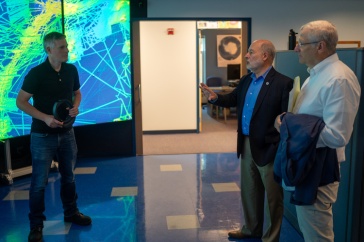
Illustration of the neutron PSR J0437-4715 as seen from Earth (left) and as seen from the star's equatorial plane (right). The purple-pink color indicates the temperature of the hot spots at the poles. White is relatively cool; purple is hot. Credit NASA/Sharon Morsnik/Devarshi Choudhury et al.?
Neutron stars — dead stars with a mass of up to two times our Sun squeezed into a ball the size of New Hampshire’s coastline — are among the densest objects in the universe. The composition of their interior holds clues to the expansion of the universe and the creation of black holes.

A series of new scientific studies published in The Astrophysical Journal Letters, including one led by UNH Ph.D. candidate Nathan Rutherford, pinpoint the diameter and mass of our nearest neutron star and provide insights into the composition of their interiors — and will help us better understand the interiors of neutron stars throughout the galaxy.
Based on new measurements of neutron star PSR J0437, called a millisecond pulsar, using data from NASA’s NICER (Neutron Star Interior Composition Explorer) X-ray telescope on the International Space Station, Rutherford and his collaborators determined that our knowledge of neutron star interiors is now driven by the data we collect rather than theoretical assumptions. This allows for more confident determination of the size and composition of all neutron stars.
“Before this work, we were under the impression that our understanding of neutron star interiors was based more on our best physical theories than the current measurements,” Rutherford says. “Now, our knowledge of neutron star interiors is at an inflection point, where neutron star data is driving our understanding our current best theories of neutron star interiors.”
“This new research gives us valuable insight into the nature of nuclear matter and some of the most compact objects in the universe.”
The researchers, including Rutherford’s Ph.D. advisor, associate professor of physics and astronomy Chanda Prescod-Weinstein, were also able to infer that that the maximum mass of any neutron star is likely between 1.92 and 2.36 times the mass of our Sun, lower than theories previously predicted. They also constrained the likely diameter of neutron stars to between 22 and 26 kilometers, narrowing ?previous models of between 21 and 28 kilometers.
Their results also indicate that the interior of neutron stars may be composed of a different form of matter than previously thought. “It could be something like quarks, which are the subatomic particles that make up neutrons,” he says. “The pressure at the center of neutron stars is so immense that even neutrons break down.”
So why should we care about neutron stars, when even the closest one to us, the poetically named PSR J0437 of this study, is 510 light-years away? As the second-densest objects in the universe, next to black holes, they can help us understand the final state of matter before a neutron star turns into a black hole, says Rutherford. When they collide with each other, they may produce heavy elements like silver and gold. “And these sort of neutron star collisions can also tell us about the history of the universe, in particular how quickly it’s expanding,” he says.
“Neutron stars are phenomenal nuclear physics labs that access energies that aren’t available to us on earth,” says Prescod-Weinstein, who is also core faculty in women’s studies at UNH. “This new research gives us valuable insight into the nature of nuclear matter and some of the most compact objects in the universe.”
This paper, “Constraining the dense matter equation of state with new NICER mass-radius measurements and new chiral effective field theory inputs,” is one of a series of recent papers on millisecond pulsars from the University of Amsterdam and Swinburne University of Technology in Australia.
Rutherford’s research was funded by a NASA grant to Prescod-Weinstein.
-
Written By:
Beth Potier | UNH Marketing | beth.potier@unh.edu | 2-1566



















































